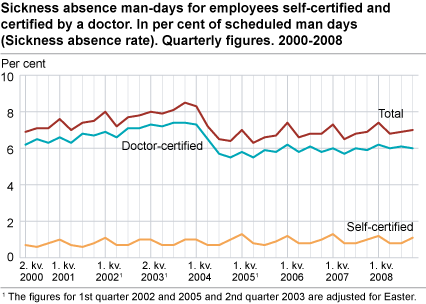Content
Published:
This is an archived release.
Moderate increase in sickness absence
Industries particularly affected by the financial crisis had a certain growth in sickness absence from the fourth quarter of 2007 to the fourth quarter of 2008. On the other hand, the total sickness absence had a slight increase from 6.9 to 7.0 per cent.
The increase was largest in construction, manufacturing of fabricated metal products and motor vehicle parts, sale of motor vehicles and certain real estate and other business activities. While the gain in the total sickness absence (self-certified and doctor-certified) was 1.7 per cent last year, the increase in these industries was more than 5 per cent. Many of these companies had a period of temporary redundancies or redundancy notices.
Increase in the private sector
The sickness absence increased by 3.3 per cent in the private sector and public enterprises. In central government (including health enterprises) and local government the sickness absence decreased by 1.2 and 0.8 per cent respectively.
Rise for men
Men had a larger portion of the employees in the private sector than women, and especially in industries affected by the financial crisis. The doctor-certified absence for men contributed to the increase in the total sickness absence. The self-certified sickness absence for men rose by 1.7 per cent.
The sickness absence level for men is however still lower than for women; 5.5 and 8.8 per cent respectively.
Increased proportion of long-term absence
The proportion of sickness absence certified by a doctor and lasting for more than 31 days rose from 60 per cent to 60.6 per cent from the fourth quarter of 2007 to the fourth quarter of 2008. The proportion of self-certified sickness absence compared to the total sickness absence rose from 14.8 to 14.9 per cent.
Decrease in the sickness absence among older women
The sickness absence for women in the age groups 55-59 and 50-54 fell by 3.9 and 2.9 per cent respectively. For women aged 20-44 years there was an increase in the sickness absence. The growth was strongest among the age group 35-39, with 3.4 per cent.
The sickness absence for men increased, and the age group 25-29 had the strongest growth with 6.1 per cent.
These results are based on data on sickness absence certified by a doctor, as the survey on self-certified absence does not contain data on sickness absence by age.
Technical informationSickness absence rate The sickness absence rate measures man-days lost due to own sickness as a percentage of scheduled man-days. Rates of change The sickness absence rates are presented using one decimal point. When we calculate the rates of change, we use more decimals in order to get more accurate figures. These will therefore differ somewhat from the rates of change produced when using the published rounded figures. The statistics do not cover self-employed persons. |
Tables:
- Table 1 Sickness absence man-days for employees self-certified and certified by a doctor. In per cent of scheduled man-days (Sickness absence rate). Quarterly figures. 2000-2008
- Table 2 Sickness absence man-days for employees self-certified and certified by a doctor, by sex. In per cent of scheduled man-days (Sickness absence rate). Quarterly figures. 2000-2008
- Table 3 Sickness absence man-days for employees self-certified and certified by a doctor, by industry and type of sickness absence. In per cent of scheduled man days (Sickness absence rate). Quarterly figures. 2000-2008
- Table 28 Sickness absence by type of absence(self-certified or doctor-certified) and duration within the quarter
- Table 33 Change in per cent of the sickness absence rate for employees self-certified and certified by a doctor, by industry and type of sickness absence. Quarterly changes. 2000-2008
Tables
Contact
-
Arbeidsmarked og lønn
E-mail: arbeidsmarked@ssb.no
-
Unn H. Høydahl
E-mail: unnh.hoydahl@ssb.no
tel.: (+47) 40 90 23 77

